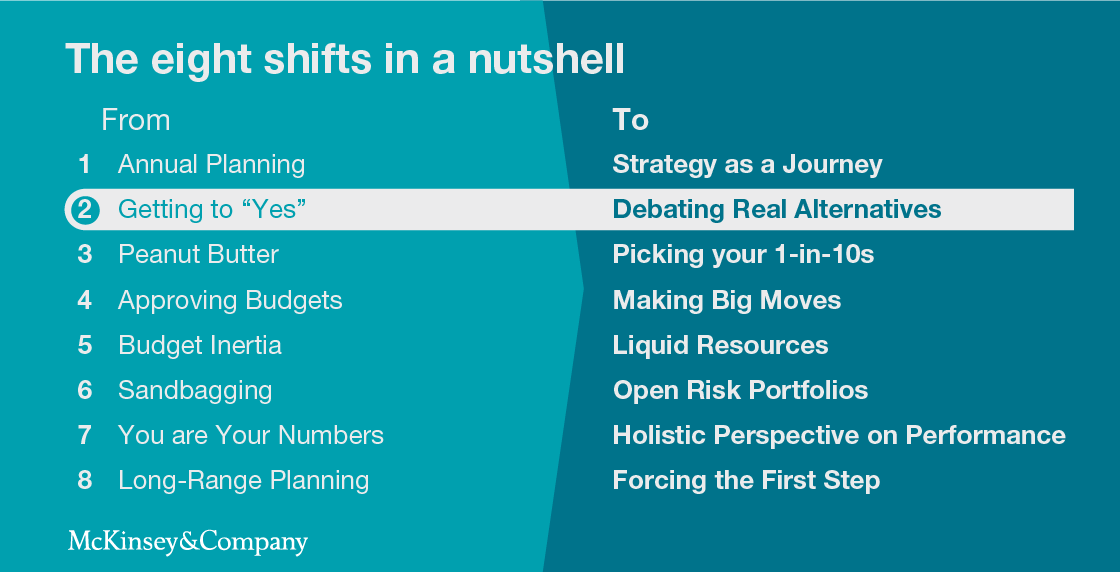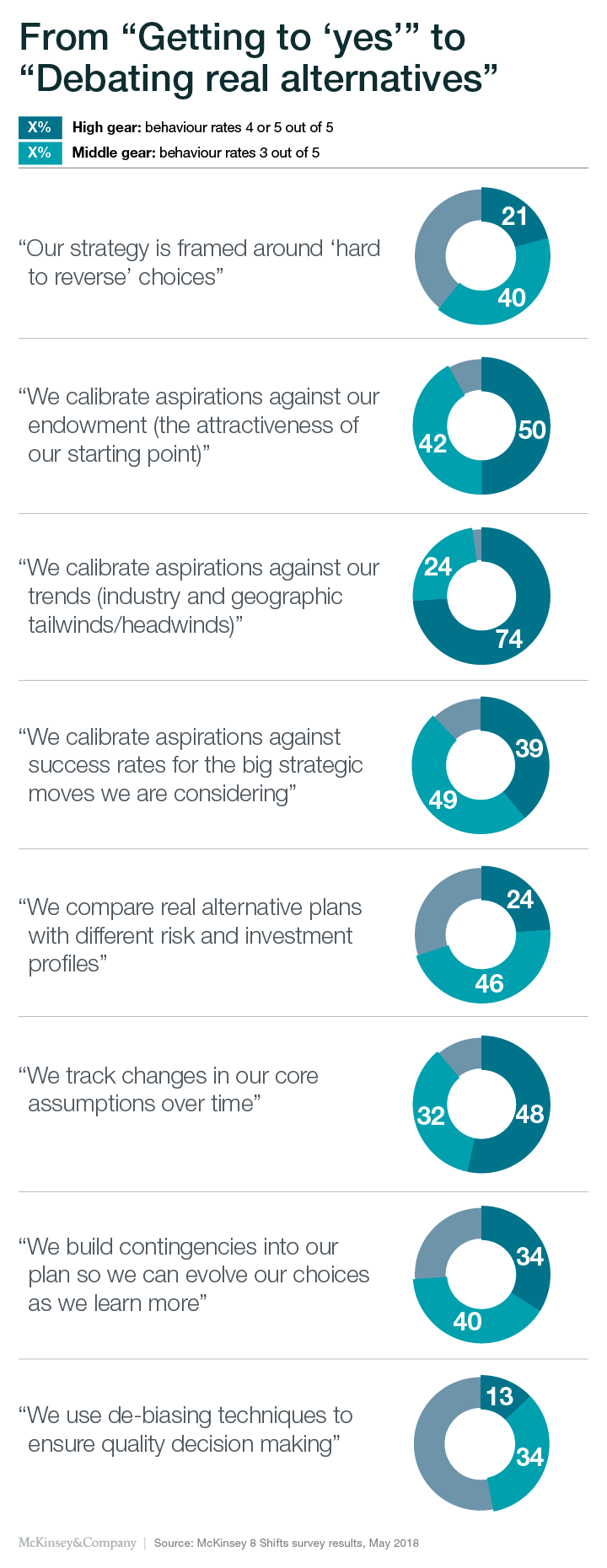Business leaders know well what’s expected of them in a strategy meeting: to approve or reject the single proposal put forward, typically in a numbing 150-page presentation. Question the plan’s premise or float alternative options and you cause consternation around the table. Chances are the presenter will suggest “taking that offline,” or will direct you to an appendix on page 148 of the PowerPoint. The goal, simply, is to get a “yes” to the plan.
It shouldn’t be this way. Weighing strategic alternatives—such as different combinations of moves and scenarios with different levels of resources and risk attached—is the essence of strategy development. Think of it this way: The goal of strategy is to make hard-to-reverse choices about how to win; planning is about making those choices happen. But in strategy planning discussions, we often skip the first step and go directly to the second, even if we try to make ourselves feel better by labeling the plan as “strategic.”
There’s simply no point in precisely planning for the wrong future. So how can you refocus the conversation so it becomes a debate about real alternatives? This is one of the eight shifts that can put your strategy into a higher gear.

Frame the strategy as choices. Instead of your strategy meeting being a plan-making exercise, reframe the agenda to focus on making choices. One way to do that is to build a strategy decision grid encompassing the major axes of hard-to-reverse choices. Think of them as the things the next management team will have to take as givens. Then, for each dimension, describe three to five possible alternatives. The overall strategic options will be a few coherent bundles of these choices.
Next, focus your debate—and your analysis—on the most difficult choices. One company I know brought two very different plans into its strategy discussion: The first plan assumed the existing low level of resources, and the second one represented a “full-potential” growth scenario, which necessitated dramatically higher investment levels. The second option was a new possibility resulting from a demand spike. Seen side by side, the two plans stimulated vigorous discussion about the company’s road ahead and what its aspirations for the business should be.
Calibrate your strategy. If you want a real debate, you need to compare your plan to some benchmarks. As my colleagues and I explain in Strategy beyond the Hockey Stick, the odds of a strategy leading to a significant performance improvement are knowable based on an analysis of your company’s starting endowment, the trends it is riding, and the moves you are planning.
What if every strategy proposal had a version of the endowment, trends, and moves analysis, and included an “odds score” representing the chances of the suggested strategy moving you up the Power Curve? Rather than just running through decks full of carefully curated numbers and charts, you’d have a concrete future to discuss. There is a good chance you’ll find that many of your traditional strategic options won’t work, and you may have to go back to square one. If your odds are poor, you should consider alternatives that may require making bigger or different moves than you made in the past.
Applying an empirical view to your aspirations and strategic moves can help you overcome some of the biases that bog down discussions in the strategy room. Moves on the Power Curve are relative to competition. And your competitors are trying hard to outperform and grow market share, just like you. When Bill Gates was CEO of Microsoft in the 1990s, he spent as much as half of the time during product review sessions interrogating developers about what they were hearing about competing products and what, theoretically, others could do that would get in the way of Microsoft’s plans.
Even a simple calibration can stimulate debate about whether a strategy has a realistic chance of getting you where you want to go. Consider the experience of a consumer-goods company with $18 billion in revenue and the aspiration of achieving double-digit growth. The company did a great deal of planning, and the aspiration, which rested on a bottom-up aggregation of each business unit’s plans, looked reasonable. However, publicly available information showed that among industry peers within the same revenue range, only 10% generated sustained, double-digit growth over 10 years.
The questions became: Is our strategy better than 90% of our peers? Really? What makes us stand out, even though we performed like an average company over the prior five years? The discussion was uncomfortable but important, and it contributed to a strategic reset for the company.
Compare alternative plans. I can hear you think, “Great—more data. Isn’t that just an invitation for the next game of getting to a ‘yes’?” Maybe. But you can try to avoid the problem by forcing the discussion to focus on strategic alternatives that management believes to be at similar risk and return levels, instead of a single big move. Then ask the team to weigh which big move to make.
Alternatively, you could show different plan scenarios with different levels of resources and risk. This way, you can make real, quantified trade-offs rather than being forced to make all-or-nothing choices.
Track assumptions over time. A few short weeks after the plan is developed, the detailed assumptions go into a fog of memory. The variance to budget gets tracked very carefully, but few review the underlying assumptions, such as uptake rates, market growth, and inflation rates.
Come approval time, we love concrete plans, but developments in the real world don’t always cooperate. Let’s stop planning as though we know the future. Instead, decide what you can today with the information you have, and build explicit trigger points into the strategy to revisit decisions as you learn more. Treating strategy as a journey will enable this.
Remove bias from decisions. Warren Buffett is said to operate with red and blue teams, even at times hiring two investment banking groups to evaluate a possible acquisition. One argues in favor, the other against. Both are offered success fees, payable only if Buffett decides that their argument wins. Private-equity firms have found that more than 30 % of decisions are different when opposing possibilities are pitted against each other. That is a big deal!
There are, of course, many other great de-biasing techniques. One I use regularly is a pre-mortem, where I ask the team to assume a strategy has failed to achieve its intended objective after, say, two years. Then you brainstorm about what caused the failure and how it might have been avoided. This safely gets many big issues out on the table.
Changing the nature of the strategy conversation isn’t easy. Judging by a recent survey we conducted, business executives particularly struggle with removing biases from decisions and ensuring that their discussion focuses on hard-to-reverse choices. On the upside, almost all respondents report that they pay close attention to industry and geographic trends, calibrating their aspirations accordingly.

Reframing the strategy discussion to focus on fundamental strategy choices will bring your qualities as a business leader into the spotlight. You may throw some managers for a loop, but your company’s shareholders will thank you for it.
Chris Bradley is a partner in our Sydney office and co author of Strategy Beyond the Hockey Stick with Martin Hirt and Sven Smit.
This article was originally published on LinkedIn.
